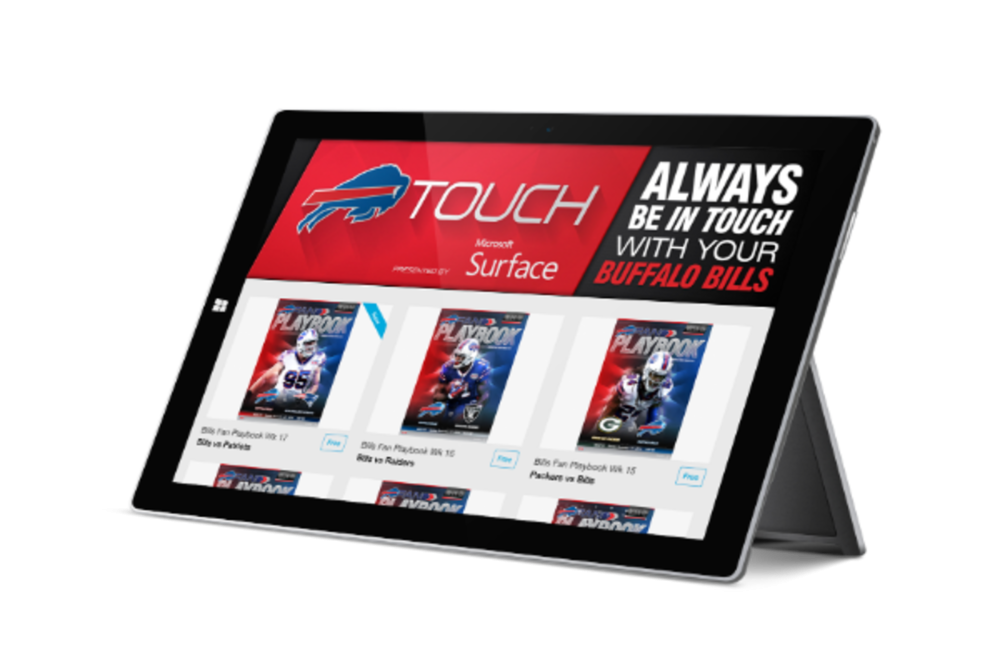Marketing is a lot like football: Sometimes you win; sometimes you lose. But when marketers focus on engaging their customers and creating winning experiences, that’s when they clinch a victory: customer loyalty. NFL team the Buffalo Bills experienced this firsthand when it launched a content-focused tablet app to engage fans outside of Ralph Wilson Stadium and connect them to the game-day experience.
Kicking off
Although the Bills are based in New York, the football team has fans all over the world. And, of course, not every diehard can attend every game. Even season ticket holders miss about half of the season due to away games. So, the Bills wanted to find a way to give fans watching at home a way to connect to the game-day experience and be knowledgeable about all of the activities happening on and off the field—kind of like a game-day program, notes Aaron La Porta, graphic designer and developer for the Buffalo Bills.
“If you’re not at a game, how can you follow along?” he says. “What’s a way for you to connect with the team? How can you feel like you’re experiencing it? Maybe not at the same level of being there, but maybe something that bridges that gap a little more.”
To help tackle this problem, the team launched the Buffalo Bills Touch app at the beginning of its 2013 season.
Creating a seamless play
The Buffalo Bills Touch app is designed specifically for tablets. Using Adobe’s creative tool InDesign and the content-based app builder Adobe Digital Publishing Suite (DPS), the Bills create a weekly folio, or issue, called the “Fan Playbook,” which contains a range of engaging and interactive content. For instance, a folio may contain video trailers aimed at firing up fans for the upcoming game, game-day photo galleries, Web overlay content and live Twitter feeds, and soundboards where fans can listen to legendary play calls and the Bills fight song.
Some content is even updated throughout the game. For instance, if fans visit the app before kickoff, they may see images of the Bills players warming up on the field; however, if they check back after the second quarter, they may find photos of a big play.
“We throw the term second screen around quite a bit, and I think that it’s becoming more important, especially in the sports entertainment field,” La Porta says. “To be in the game [and] to be able to have that kind of content for fans to digest while they’re watching the game is huge.”
Building momentum
To get people to download each week’s folio, which are published on Adobe DPS servers every Thursday during the season, the Bills rely on its website, email blasts, social media, and text notifications for iOS users. And these channels have helped the team score some winning results. In fact, when comparing the Bills’ 2013 and 2014 seasons, the number of app downloads has more than doubled, La Porta says.
Despite this success, the Bills continue to face a few challenges. One is staffing. La Porta says that he’s one of two people working on the Touch app, which can put a strain on trying to produce engaging content within a limited amount of time. There are also obstacles that are out of La Porta’s control. Consider team performance, for instance. If the Bills lose two games in a row, he says, there is a drop in interest and people won’t download the folio until right before the next one. But if the Bills come off of a big win, the number of downloads on Thursday increases, he says.
However, the team has secured some wins in terms of insight. And most of these insights are driven by consumer feedback. For instance, when the Bills first launched the app in 2013 it was only available to iOS users. Shortly after the app’s debut, the Bills began to receive comments from consumers via iTunes and the team’s customer touchpoints asking for Android and Windows versions.
“The Internet has a way and the fans have a way of telling us very directly what they want and what they need from the team—aside from what’s going on on the field,” La Porta says. “When we published the app in iOS only, I would say that every third response or feedback that we got was, ‘When is Android coming?’” So, in 2014 the Bills branched out to both the Android and Windows markets, which was important—La Porta notes—given that Windows Surface is an official sponsor of the NFL. And, Android and Windows users have now surpassed iOS fans.
The Bills can also gain insight via customer surveys that it includes in each folio. In one instance, this direct feedback revealed that video is a preferred form of content for fans.
Finally, analytics shed light on where the Bills can improve. Consider the following: After using the analytics tool within Adobe DPS, the team’s marketers learned that Sunday morning was the most popular time to download the weekly folios, even though the Bills push them out on Thursdays.
Gearing up for next season
Although the Bills aren’t currently playing, La Porta acknowledges that the team doesn’t really have an offseason. In fact, he already has aspirations for this upcoming football season. For one, he’d like to attach more sponsors to different content sections to offset costs.
And, like a true athlete, La Porta knows that he can always up his game.
“Based on the passion, the fans, how the team is doing, I can always make the app better, more streamlined,” he says. “I can always try something new and approach a hurdle within the development in a different way. It really helps me become more versatile and open-minded in terms of finding solutions that work from this medium.”





